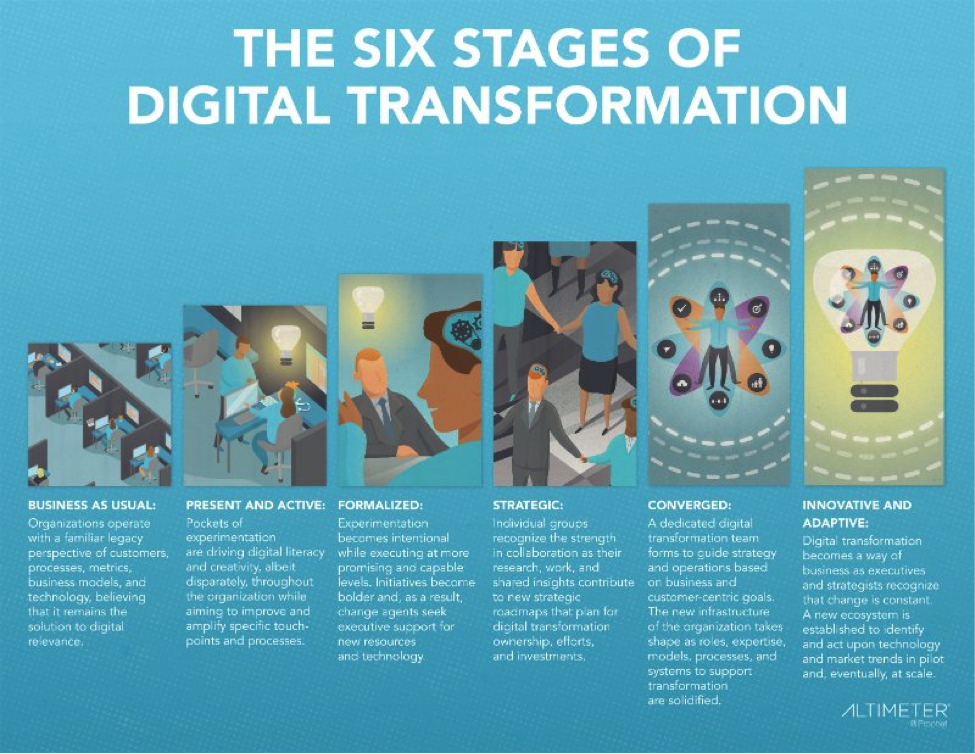Stop Talking About Digital Transformation and Just Change Already
We live in a time of digital Darwinism, an era in which technology and its impact on business is constant, yet with varying but inevitable degrees of disruption. The evolution plays out differently in each industry and each organization. Digital Darwinism is enriched though changes in people (your customers, employees and stakeholders) and the resulting market advancement. As such, it’s less about the origin of the species and more about its fate.
Survival, which is tough enough, takes an intentional, informed effort to drive business evolution and modernization. To thrive, however, takes something more. Executives must see and live the world through the lives of those who truly utilize the newest technologies. An executive can define their destiny and legacy with a successful implementation.
A vast chunk of my work involves either speaking to executives at events around the world or interviewing them for research. Prior to every engagement, I ask what they hope to get out of the session. Every session I hear the same thing. “We get that things are changing, we already know that. What we need to know is how to change, how to get support from all areas, and what exactly we need to do,” I hear time and time again.
There is, unfortunately, no easy prescription for change. Furthermore, just because executives realize there are digital changes afoot doesn’t mean that they understand why, to what extent, and how it differs from their perspective of the change.
The best way to help executives embrace real change was to deliver a roadmap of how to see the world differently, through the eyes of their customers and employees, alongside delivering shareholder and stakeholder value. A pathway to digital transformation can be found in the common steps of a businesses’ evolution in the steps that are taken as a result of empathy, fresh perspectives, and clear direction.
Competing for the Future, Today
Digital transformation is a global business movement that involves using technology to radically improve the performance or reach of an enterprise. Technology alone isn’t the solution to performance – implementation is as well. This is a massive, global trend. Yet, the term “digital transformation” means different things to different people. I define it as follows:
Digital transformation as the realignment of /or new investment in technology, business models, and processes to create new value for customers and employees and more effectively compete in an ever-changing digital economy.
Inevitably, all facets of business must work together under a common vision and aspiration if it is to excel in an era of digital Darwinism.
What started as enterprise initiatives led by progressive CIOs and IT organizations has spread throughout every facet of business. Over time, executives in other critical functions also led investments to bring their own technology roadmaps to life. In some cases, there’s internal competition between groups. For example, CMOs are often cited as the rival to CIOs in spending when it comes to new technologies and resources. Inevitably, all facets of business must work together under a common vision and aspiration if it is to excel in an era of digital Darwinism. This, I’ve learned, is something that happens only after departments attempt change independently. Eventually, the momentum shifts to drive collaboration across the enterprise.
In 2014, I published a “State of Digital Transformation” report that found 88% of companies surveyed claimed to be undergoing digital transformation. But the same research revealed that only 25% had actually studied or were studying the effects of digital Darwinism. Clearly, there was much to learn.
Years of research have shown that digital transformation is a movement progressing without a universal template or map. Lacking guidance to move through proven and productive passages, most businesses pursue change from a known, safe approach that correlates with “business as usual” practices. Operating within the confines of traditional paradigms can challenge the direction, capacity, and agility for thriving in the digital economy.
Introducing a Maturity Model To Guide Your Digital Transformation
Over the last three years, I’ve studied the maturity paths of some of the world’s largest brands including Dell, Discover, GM, Harvard, Lego, Metropolitan Museum of Art, Nestlé, Novartis, Sephora, Starbucks, Target, to name just a few. I’ve captured my findings in a new report, “The Race Against Digital Darwinism: Six Stages of Digital Transformation.”
This report introduces a maturity framework that documents how companies advance technology roadmaps, business models and processes to compete in the digital economy. The model was developed to help CIOs, CMOs, CDOs, and other key stakeholders follow the paths of other successful companies. It’s meant, to a greater degree, to provide a “checklist: to guide, justify, validate, and effectively make the case for driving transformation.
Universally, mature companies establish a purpose to create the kind of holistic alignment that inspires and drives enterprise-wide change. Across the board, customer experience (CX) often served as a primary catalyst for bringing CMOs and CIOs together to jointly lead digital transformation efforts.
Through the lens of customer experience, digital transformation progresses through organizations through six stages:
In this report, I introduce each of the six stages as a self-contained phase, offering a narrative and a checklist to guide your journey. Since the text may be small above, here’s a summary of the steps an enterprise will take.
- Business as Usual: The organization persists with their legacy perspective of customers, processes, metrics, business models, and technology, as the solution to digital relevance.
- Present and Active: Small pockets of experimentation emerge across the organization. The increased digital literacy and creativity aim to improve and amplify specific touchpoints and processes.
- Formalized: Experimentation evolves into intentional execution. Initiatives become bolder, resulting in requests for executive support for new resources and technology.
- Strategic: Individual groups recognize the strength in collaboration. Their shared insights contribute to new strategic roadmaps that plan for digital transformation ownership, efforts, and investments.
- Converged: A dedicated digital transformation team forms. They guide strategy and operations based on business and customer-centric goals. The new infrastructure of the organization takes shape, as roles, expertise, models, processes, and systems are finalized.
- Innovative and Adaptive: Digital transformation becomes a way of business as executives and strategists recognize that change is constant. A new ecosystem is established to identify and act upon technology and market trends in pilot and, eventually, at scale.
As a whole, these phases are steps in a maturity blueprint to guide purposeful digital transformation. While there are many pathways toward change, a universal catalyst for driving the digital revolution was the Digital Customer Experience (DCX), alongside technology and other market factors.
That being said, companies may span multiple stages at once depending on their goals, resources, and overlapping initiatives. Use this framework to validate, benchmark, and map your company’s progress toward digital literacy and leadership. Keep in mind, however, that you may find yourself revisiting and overlapping stages throughout deployment.
Chart Your Course
Digital transformation opens the door to new opportunities for innovation in how to design, integrate, and manage customer (and employee) experiences. By following a digital transformation model, all aspects of business evolve, including management perspectives, roles and responsibilities, operations, work, and, ultimately, culture.
The Six Stages of Digital Transformation represents a journey to evolve with and push ahead of technology and market trends – cloud, anyone? It is an ongoing pursuit that makes change less about immovable stages and more about an evolving vision/purpose that resolves to engage a connected generation of customers and employees. The collective efforts of individuals, groups, and the collaboration of cross-functional roles pave the way for a new era of business, work, and customer centricity. I hope you’re ready. If you are interested, you can download the report here.






